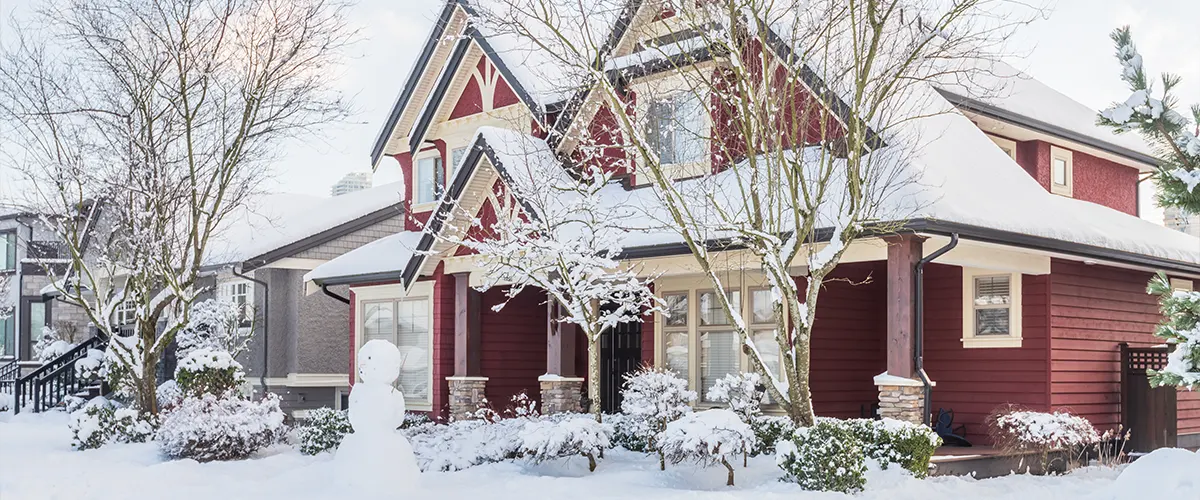Winter in Johnson and Jackson County might not be like the ones in Canada, but it can still create problems for your deck.
Snow piling up on your deck is the most common concern homeowners have for good reasons. Decking and deck frames can fail under a lot of pressure, and wood can get damaged by sudden changes in temperature.
But what is the best way to remove ice and snow off your composite deck?
Here are some helpful tips to get you through the winter without causing damage to your new composite decking.

Brooming Snow Off Your Composite
Before reaching for the snow shovel, consider using a broom if your deck has a little snow that’s light and fluffy. With a push broom, you won’t risk damaging your decking at all.
A leaf blower is another zero-risk option to clean small amounts of snow from your decking. Light snow, up to a couple of inches, will be easily removed with a leaf blower working at a fast rate.
We talk about shoveling snow off your composite decking here.
Using A Snowblower On My Composite Deck.
Using a snowblower on composite decking is a risky endeavor. Personally, I don’t recommend using such a heavy machine to clean a rather small area like a deck, but it’s up to you if you want to risk it.
One of the main reasons I avoid doing it is because different, small obstacles can hide underneath the snow. If they get caught in the snowblower blades (or paddles), you don’t want to be anywhere near your snowblower.
Objects trapped inside the snowblower are thrown at high speeds and can damage your home’s siding or even break windows.
However, if you still want to give it a shot, here are some tips to prevent damage when using a snowblower to clear the snow off your composite decking.
- You only want to use a single-stage blower on your deck. These blowers with rubber paddles spin at a high rate to collect and throw the snow. They're available in both electric or gas, and many homeowners already have one sitting in their garage.
- To successfully use a snowblower on your composite deck, you want to take the same approach as you would with shoveling. Run the blower lengthwise down your deck. Be careful not to catch the plastic blade on the bottom of your snowblower on the edges of your decking.
- If you have adjustable paddles, raise them high enough so they won't touch the surface of your composite decking. I have seen deck boards damaged accidentally from the snowblower paddles without them even directly touching the surface.
I recommended clearing snow off any deck, be it composite decking, wood decking, or PVC decking, the old-fashioned way, with a shovel.
Maybe a shovel won’t cut if you have a bigger deck and too much snow. In that case, I suggest contacting a snow removal company in your area to handle the job.
What Ice Melt To Use On My Composite Decking?
Decking contractors have mixed feelings about using ice melt on your composite decking.
Personally, I’d rather keep my family safe and use ice melt when needed. If you’re using your deck to access your backyard, to let the dogs out, or it’s your second exit from the house, I recommend using ice melt to make it safer.
However, if I knew no one would be using the deck in the winter months, I wouldn’t worry about melting the ice on composite decking. Your deck will thaw on its own from the sun’s natural light as the temperatures increase.
Below are a few recommendations for de-icing your deck.
- Be careful what products you're putting down on your composite deck. Look for ice melt that's pet, vegetation, and concrete safe.
- Decking manufacturers also recommend using a calcium chloride-based ice melt without coloring or dyes. Most manufacturers have products they recommend on their websites. Each manufacturer's recommendations vary slightly, so we recommend finding out exactly what your specific decking manufacturer suggests.
- Avoid using sand or other products that contain rocks or fillers on your composite decking to prevent damage.
- After the season is over, rinse your decking with your garden hose to remove any excess ice melt and debris from the winter months.
Conclusion
Ice can be extremely dangerous, especially for the elderly. Stairs, railings, and at least a small path must always be available and safe for anyone to use.
We recommend anti-slip mats and constant maintenance whenever it’s snowing. Broom your composite decking whenever possible, and don’t allow snow to pile up.
If a broom doesn’t do any good, a plastic shovel will work to clear a path and make your outdoor space safer for minimum usage.
In case there’s already too much snow piled up, a snow removal company will be able to fix the problem.
Get in touch or browse our blog for more information on your decking or fencing maintenance!

